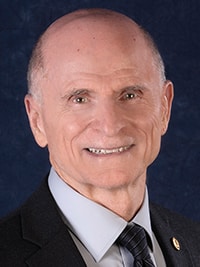We are the patient’s doctor
Donald S. Karcher, MD
November 2023—For 100 years, pathologists have been called “the doctor’s doctor.” We have traditionally done our work in the background, interacting mostly with other physicians and not visible to or known by patients.
But this is no longer true for today’s pathologist. I am on a real crusade to make sure that pathologists remember that we are in fact the patient’s doctor. As your CAP president, one of my goals is to encourage all pathologists to be more visible to our patients, and to stop thinking of ourselves as somehow different from (or even less than) other physicians.
If you have not already seen these changes in your own daily practice, I suspect you will soon. More often than ever, pathologists now interact directly with patients, answering their questions, reviewing with them their lab findings, and sometimes showing them the slides from their specimen. Some pathologists have even started formal patient-pathologist consultation services. Clinging to the outdated model of pathologists as responsible primarily to other physicians is a disservice to the relationship we should have with our patients.
Where I work at George Washington University, our residents can attest to my strong feelings on this front. In many environments, pathologists reporting results or seeking more information will say they’re going to “call the clinicians.” At GW, we do not allow our residents to say that, because we are clinicians too. Instead, we say we’re going to call the surgeon, or the oncologist, or whatever other physician is overseeing the patient’s management. Some people might see this as only a matter of semantics, but I believe it is much more important than that. Whether we see ourselves as the doctor’s doctor or as our patients’ doctor affects how other physicians see us, how we view ourselves in relation to others, and in the end how our patients view us.

Dr. Karcher
Our role with other physicians has also changed significantly in recent years. Where other doctors used to see pathologists as part of some black box—only noticing us as the signature on a pathology report or lab result—now we are their colleagues at tumor boards, we are trusted sources to help interpret complex genomic data and myriad other lab results, and we provide formal consultations for their (and our) patients. We are more visible to our clinical counterparts than ever before.
For many of us, these formal consultations are the biggest change in our day-to-day work. We are all used to the “curbside consult.” For decades, pathologists have been on the receiving end of those requests for quick opinions or answers to brief questions. Whether we are helping our colleagues understand a new WHO classification or decide on the next testing steps, we are very comfortable with this role.
But the perspective we can offer for other clinicians and for our patients goes well beyond those quick calls. That’s why the CAP was instrumental in establishing new billing codes so we can now be paid appropriately for our expertise. It’s also why many pathologists have stepped out of the shadows of the curbside consult and into the light of formal consultations. We respond to an order from another physician (a written, electronic, or verbal order is sufficient) and provide a consultation that meets various requirements, including a written consultation report that goes into the patient’s record. This often goes above and beyond our usual diagnostic work. With a formal consultation, we review how the pathologic and other findings fit into the patient’s clinical situation, recommend additional testing that might be needed, and/or discuss prognosis and treatment options in the context of the patient’s diagnosis.
Many pathologists are still getting their arms around the fact that we can now do these formal consults—and even bill for them—but this is what every other specialist in medicine does. If you are wondering how to take the next step with these consultations, I encourage you to check out a paper I was invited to write for Archives of Pathology & Laboratory Medicine earlier this year (Karcher DS. Pathologists as clinical consultants: for the patient and with the patient. Arch Pathol Lab Med. 2023;147[4]:418–424). It offers a step-by-step look at what’s involved in formal consultations and how to get more comfortable interacting directly with patients.
I am encouraged that pathologists are finally being accepted as having equal footing with our clinical colleagues. That matters for our patients, who should know where their diagnosis and laboratory results come from and be able to ask the pathologist if they have questions. It also matters for our own profession. When medical students think of pathologists as ancillary, or as people in the background who just generate reports, they are less likely to see the value of becoming pathologists themselves. Filling our pipeline with great talent depends on showing students that pathologists make as much of a difference to patients as any other physician on the team. As pathologists, we have always understood our value to patients—now it’s time to make sure that our clinical colleagues and our patients understand that as well.
Dr. Karcher welcomes communication from CAP members. Write to him at president@cap.org.
 CAP TODAY Pathology/Laboratory Medicine/Laboratory Management
CAP TODAY Pathology/Laboratory Medicine/Laboratory Management
